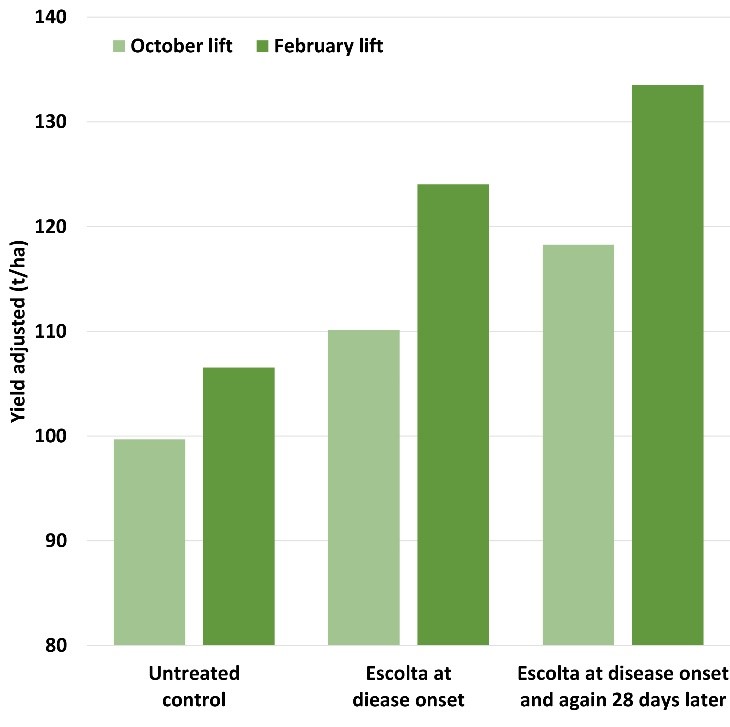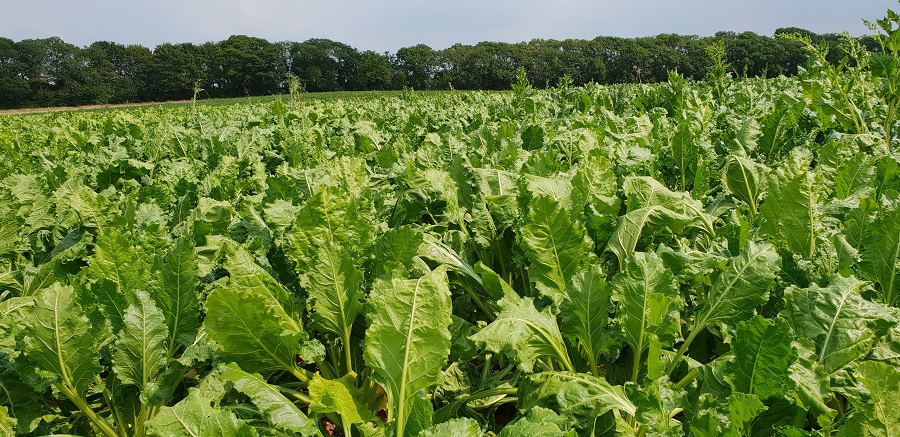Challenging is the word that best describes the 2020 season to date and none more so than in sugar beet. CPM catches up with the up and downs of the spring and looks ahead at the fungicide decisions soon to be made.
Aphids arrived 2-2.5 weeks earlier than normal.
By Lucy de la Pasture
For Arable Alliance agronomist, Andrew Wells, the sugar beet crops under his care have fallen into two very different categories, depending on soil type. On light land, seedbed preparation wasn’t a problem, so earlier drilling was possible after the very wet Feb and the beet got off to a flying start.
“On the lighter land the moisture was conserved and, as a result, beet emergence was very even and establishment was high. That good start has meant those crops have been a pleasure all season and crops met across the rows three weeks ahead of the target date of the Lincolnshire show (circa longest day).”
Andrew has tweaked herbicide programmes to major on contact activity when conditions turned resolutely dry during March, April and May, where his Nottinghamshire/Lincolnshire patch had just three rainfall events resulting in a total of 27mm.
“I found referring back to the old Betanal Tandem (phenmedipham+ ethofumesate) label was helpful in making best use of the contact actives available to us during a time when residual chemistry, such as Goltix (metamitron) and Venzar (lenacil), wasn’t providing much efficacy.”
It’s been a very different story on the heavier-bodied soils, says Andrew. “Seedbed creation was more difficult and valuable moisture was lost which wasn’t replaced by rainfall. Some of the beet was irrigated to get it going but in general the emergence of beet and weeds has been staggered and some has still not emerged.”
Having beet at different growth stages has presented challenges when it comes to weed control. “Herbicides had to be gentle – in some fields I’ve had some beet with two leaves and others at 8-10 leaves,” says Andrew.
Where big weeds have got away growers have resorted to inter-row hoes, with some now using ‘smart’ technology where the hoe is camera-guided with great success, he says.
Fellow AICC member Sue Lord echoes Andrew’s experience, describing the beet under her care as either ‘very good’ or ‘patchy’. Consequently weed control has also been variable, with residual herbicides proving fairly ineffective in the dry conditions.
“Conditions have made blackgrass control with Centurion Max (clethodim) particularly difficult. It’s not the easiest product to use at the best of times, but the requirement for an interval of 14 days after application before applying other herbicides was an added challenge this spring.”
Volunteer potatoes are the worst Sue has seen in crops for some time and, where present, have added to the cost of weed control programmes, although they have generally been well controlled using Shield (clopyralid) with a little extra help from Debut (triflusulfuron-methyl) and ethofumesate. Fat-hen has been another weed that has enjoyed the dry conditions and has had multiple flushes this spring, she adds.
The prolonged emergence hasn’t helped virus yellows control programmes, particularly as mature plant resistance doesn’t kick-in until the beet plants reach the 12-leaves stage.
“Aphid control started in some crops on 8 May and predators have been late to the party after the extremely wet winter,” says Andrew. “That’s meant we’ve had to use 2-3 insecticides in many crops but fortunately Biscaya (thiacloprid) is very tank-mix friendly so herbicide applications haven’t been compromised.”
Sue has generally managed with two insecticides, allowing predators to take on aphid control as beet plants get bigger.
“Aphids arrived 2-2.5 weeks earlier than normal and have presented a few difficulties in crops, particularly where the growth stage of beet varied from just emerged to 4-8 leaves across the field. I’ve been finding aphid numbers in crops that make the thresholds look a bit meaningless,” she says.
On a recent crop inspection Sue found 10 wingless aphids on a leaf where the crop had been sprayed with Teppeki (flonicamid) less than a week ago, demonstrating the speed at which they’re building up in June.
“In most crops, aphid numbers have already peaked and, a bit like COVID-19, the numbers are slowly dropping off. They’re easy to miss and I’ve found a hand lens has been essential to get a good picture,” she says.
The impending loss of Biscaya is going to make aphid control much more difficult, not just in sugar beet (where it currently has an EAMU) but in potato and vegetable crops, adds Andrew. “With just one insecticide fully approved for use in sugar beet, no longer having access to Biscaya, and the two sprays it offers, is likely to present a very real problem when it comes to aphid control.”
Both agronomists report suspicious signs of yellowing in some crops that may or may not be due to virus yellows. With the number of aphids it’s inevitable that there will be more virus yellows in crops than last season, adds Sue.
“At least next season it’s hopeful Insyst (acetamiprid) will have a full label approval for use in sugar beet but controlling virus yellows in future is still a worry. All the insecticide options are pretty costly given the sugar beet price is £19-20/t.”
One of Andrew’s growers has the ALS-herbicide tolerant Conviso Smart variety Jannika KWS in the ground this season, the first time it has been commercially available. Andrew’s impression has been that the herbicide label for Conviso One (foramsulfuron+ thiencarbazone-methyl) is far too restrictive in a spring like the one we’ve just experienced.
“Currently Conviso One is limited to a single application from the 4-8 leaves stage of the beet in the UK, which is different to Europe where two applications are permissible,” he says.
It’s really something that needs reconsidering, Andrew believes, and he anticipates the crop will require a tidy-up in backward areas using conventional herbicides which adds to the overall cost of the system. Beyond herbicide decisions, plenty of agronomy challenges still lie ahead, with an eye now turning to disease control.
Andrew plans his fungicide programme according to the anticipated lifting date of the crop, with two fungicides being the norm and three where lifting takes place the other side of Christmas.
“I plan to apply at the first sign of foliar disease, which is likely to be either rust or powdery mildew, and I’d normally recommend Escolta at this timing (cyproconazole+ trifloxystrobin).”
Sue is of the same opinion, with Escolta at a full rate, followed by either a full or reduced rate, depending on lifting date and disease pressure. If a third fungicide is needed for late-lifted crops, then a straight epoxiconazole will be sufficient to keep cercospora and ramularia at bay.
Look out for early disease
The continued mild weather means foliar diseases are likely to arrive earlier and present a sustained threat to sugar beet in 2020, according to Ed Hagues, Bayer campaign manager for root crops.
“As has been the case in recent seasons, rust is likely to be the principal disease to threaten performance,” he says.
Wind the clock back several years and it was powdery mildew that was the primary disease to threaten the sugar beet crop and its impact could be forecast based on the number of ground frosts during Feb and March.
Unfortunately there are no such forecasts for rust, but experience has shown that mild weather is important to disease development and in favourable conditions it can spread quickly.
“2015 and 2016 were both high pressure years and some growers were caught out by how early beet rust arrived. In a typical year it can be found from July, but growers should monitor crops from June onwards,” he suggests.
The BBRO advice on disease control is to apply the first fungicide at full rate at disease onset (cost approx. £28/ha), with a second application four weeks later (with a minimum interval of 21 days). More than a decade of fungicide trials confirms their value to protecting performance. The yield of treated over untreated crops from 2019 trials highlight the significance of application timing in a high-pressure year.
“Oct-lifted crops that received two applications of Escolta – which follows BBRO advice – yielded 18t/ha more than the untreated, a gain of about 19%. For Feb-lifted crops this increased to more than 25%. This is an exceptional level of yield protection and is more than the long-term average yield response seen in trials, revealing the true extent of disease pressure crops endured in 2019,” he adds.

Rust typically manifests as orange/brown pustules on the upper side of the leaf surface. Research suggests that left untreated, it can lead to yield losses of up to 14%, which is roughly equivalent to 12t/ha based on an 85t/ha crop. In 55 Bayer trials between 2007 and 2019, the average response to two applications of Escolta was 10.1t/ha for all crops lifted during the campaign.
A basic return on investment calculation based on a beet price of £20.99/t, a fungicide cost of about £28/ha and an application cost of approximately £10/ha reveals an average return of £136/ha and a break-even of just 3.6t/ha.
Research has shown that yield response to fungicides can be influenced by factors other than disease, such as drought stress. After one of the driest April’s on record, drought stress may be another concern heading into the summer.
On average, about 10% of the potential yield is reckoned to be lost to drought stress each year, explains Ed. “Typically, plants with 75-100% full canopies will use between 2mm of water/day on dull days, to more than 6mm/day on bright sunny days. It is not unusual for crops to be running at a deficit of 60-70mm during June.
“It’s important not to apply any plant protection products to sugar beet when plants are showing signs of wilting, but there is also a need to protect canopies if crops are to continue accumulating both mass and sugars into the autumn. Ensuring fungicides are applied outside the heat of the day and as soon as disease is detected is important to protecting performance.”




